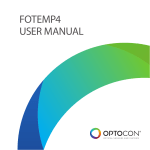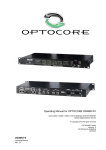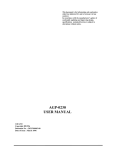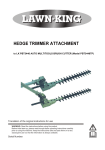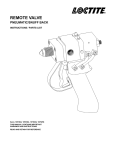Download OMC-W36 Curing Oven User Manual
Transcript
OMC-W36 CONNECTOR HEAT OVEN USER´S MANUAL Issued: March 2008 Optocon technologies s.r.o. Strojnicka 29 821 05, Bratislava Slovak republic Phone: +421 2 48205200 Fax: +421 2 48205231 E-mail: optocon@optocon.sk Web: www.optocon.sk Blank page OMC-W36 CONNECTOR HEAT OVEN USER´S MANUAL Copyright © 2000, Optocon technologies s.r.o. All rights reserved. This document was prepared for use by customers, licensees and personnel. All the information contained in this manual is the property of Optocon technologies s.r.o. and shall not be reproduced whole or in part, without prior written approval. Optocon technologies s.r.o. reserves the right to make changes without notice to the technical specification contained in this manual. The following symbols or alerts are used throughout this manual to denote safety precautions. Read and follow them carefully. The symbols and alerts have the following meanings: ! WARNING Ignoring or failing to follow items marked by this symbol could lead to severe personnel injury or death. ! CAUTION Ignoring or failing to follow items marked by this symbol could result in personnel injury or damage to the device. PLEASE OBSERVE THE FOLLOWING INSTRUCTIONS: ! WARNING • NEVER touch or put your hands or fingers on the ferrule/plug cassette block while the heating process has been started or interrupted. Actual temperature of the ferrule cassette is indicated on the LCD display. Touching the hot ferrule/plug cassette may result in serious injury. • NEVER detach the cassette from the tray immediately after finishing the heating process. Allow enough time for it to cool. Actual temperature of the ferrule cassette after finishing or interrupting the heating process is indicated on the LCD display. • NEVER touch the control panel or electrical cord with wet or damp body parts as it may cause severe shock or injury. • NEVER remove the bottom cover of the unit while main power plug is connected to electricity. Opening the unit may cause electric shock, severe injury, flash burn or death. ! CAUTION • ALWAYS use the unit at the rated voltage, as indicated on rear panel, above the inlet plug. As the unit requires proper grounding use 3-wire plug cord with a Type 3 or better grounding. • ALWAYS turn off the power and unplug the power cord from the outlet in the event of the following: - changing the fuse - any strange smells, sounds or smoke arise from the unit - the unit does not correctly respond to the commands indicated on LCD display - temperature of the curing process rises far above the preset temperature (by more than 10°C) • ALWAYS close the protective closure before starting the heating process. Do not touch the cassette and ensure the protective cover remains closed during the heating process • NEVER perform any of the following. Doing so may lead to fire, electrocution or other serious accident: - hit or subject the unit to any kind of shock - place the unit on an unsteady surface - forcibly bend and place heavy objects on the unit - cover the unit while in operation with any kind of cover disabling proper natural ventilating Blank page CONTENTS CHAPTER 1 1.1 Introduction 1.2 Standard packing items 1.3 Heat oven description, names and functions of the parts CHAPTER 2 2.1 Installation place and environmental conditions 2.2 Power supply 2.3 Installation CHAPTER 3 3.1 Software description 3.2 Operating the unit 3.2.1 Setup procedure 3.2.2 Process confirmation 3.2.3 Running the heating process 3.2.4 Interrupting the heating process CHAPTER 4 4.1 Troubleshooting 4.2 Changing the fuse CHAPTER 1 1.1 Introduction OMC-W36 is a user programmable heat oven with a vertical tray used for hardening the epoxies used during the assembly of fiber optic connectors. It is primary intended to heat the fiber optic ferrules and plug type fiber optic connectors in which the epoxies bond the optical fiber. Heating process usually consists of three (3) subsequent periods (steps): - - Temperture scale (°C) - warm up period: during this period the heat oven heats the cassette with loaded fiber optic parts (ferrules, plugs). This time period cannot be set by customer and is determined by internal components and ambient temperature. This period can be interrupted manually by the operator at anytime cure period: during this period the temperature of the cassette remains stable at certain temperature level for desired time. The temperature and time depends on epoxies manufacturer recommendations. Operator can set cure temperature and cure time manually. This period can be interrupted manually by the operator at anytime cool down period: as soon as the cure time is over, the cassette starts to cool. Cooling is caused only by the influence of an ambient environment. The unit remains in this condition unless the operator starts the heating process again. warm up period cure period = preset cure time cool down period Preset cure temperature Ambient temperature Time scale (min.) Figure 1.1.1. The heating process explanation OMC-W36 is recommended for curing the following types of fiber optic ferrules/connectors: - standard 2.5 mm ceramic, glass and metal singlemode or multimode ferrules - standard 1.25 mm ceramic, glass and metal singlemode or multimode ferrules - standard plug type fiber optic connectors with 2.5 mm ferrules (FC, SC, ST, E2000, DIN, etc.) - standard plug type fiber optic connectors with 1.25 mm ferrules (LC, MU, etc.) - FSMA905 and FSMA906 plug type connectors with 3 mm ferrule 1.2 Standard packing items In the table 1.2.1 there is a list of parts shipped with the heat oven: Part name Part Number Quantity Constituent parts: OMC-W36-X - main unit - cord holder - power plug - screwdrivers - spare fuse - user’s manual - warranty certificate Optional parts: - cassette(s) - groove plate(s) 1 1 1 2 1 1 1 pce set pce pcs pce pce pce Note check data sheet for details consist of 6 parts check data sheet for details check data sheet for details Optional parts can be ordered and shipped along with heat oven, check data sheet for details Table 1.2.1. Part list, standard and optional packing items 1.3 Heat oven description, names and functions of the parts The OMC-W36 heat oven consist of three (3) main parts: - the main unit - cord holder - cassettes for ferrules/plugs The main unit houses all crucial electrical and electronic components that are necessary for proper function of the unit. Front and back view of the main unit with names of each part of main unit is shown on figure 1.3.1. Vertical Tray Heating plate Protective cover Mains inlet Fuse box LCD display Buttons Power switch Fixing screw for cord holder Figure 1.3.1. Font and back view of the main unit The cord holder is an important part of the heat oven as it enables to hold small or large fiber coils during the heating process and during loading/unloading the cassettes. The cord holder is easily adjustable to the form that will suit most tail lengths and coil diameters. The cord holder consist of six (6) parts: - two long and one short steel bars (total 3 pcs) two clamps (total 2 pcs) one stop ring (total 1 pce) Assembled cord holder is shown on fig. 1.3.2. Clamps Stop ring Steel bars Figure 1.3.2. Assembled cord holder The cassette is the holding device for the connector components, which have to be heated. The groove plate is a part of the cassette, though it can be removed and replaced by different types of groove plates. Cassettes are of various styles, depending on the ferrule/connector type. A typical cassette with groove plate is on fig. 1.3.3. Figure 1.3.3. The cassette with groove plate CHAPTER 2 2.1 Installation place and environmental conditions It is strongly recommended to pay attention to where the heat oven will be installed. The installation place should satisfy the following conditions. Temperature: Relative humidity: Storage temperature: 10 to 40°C 15 to 85% RH (non condensing) 0 to 50°C Furthermore, the unit should not be in any of the following kind of places: - places exposed to direct sunlight - places with violent temperature swings - places frequently exposed to mechanical vibrations - places that are very dusty - places that are poorly ventilated Do not install the oven in places that are near an air conditioning vent. 2.2 Power supply Model • • • The power supply conditions for the OMC-W36 heat oven are as follows: OMC-W36-1: Power supply voltage .................. single phase AC 110V ± 10% Power supply frequency .............. 50/60 Hz ± 10% Power consumption rating ........... 250W Model • • • OMC-W36-2: Power supply voltage .................. single phase AC 230V ± 10% Power supply frequency .............. 50 Hz ± 10% Power consumption rating ........... 250W ! WARNING • ALWAYS use the unit at the rated voltage, as indicated on rear panel, beside the inlet plug. As the unit requires proper grounding use a 3-wire plug cord with a Type 3 or better grounding. Ignoring or failing to follow the above instructions can lead to permanent damage to the device and severe personnel injury or death. 2.3 Installation Please follow these steps during installation of the unit: i. ii. iii. Put the unit on a flat desk in place that conforms to the environmental conditions as listed in paragraph 2.1 Assemble the cord holder. Insert the cord holder into mounting hole on the top unit. Fix the cord holder by fixing the screw at the back panel of the unit by the screwdriver provided. Connect the power cable to the AC inlet in the back panel of the unit and plug it to a wall outlet. Check the heat oven at the end of installation by the following procedure: i. ii. Power on the unit with the power switch on the front panel of the unit. Confirm that the power switch and LCD display is lit. The following message should appear on the LCD (fig. 2.3.1): HEAT OVEN READY SETUP NEXT Figure 2.3.1. Message on LCD after power on The unit is now ready for the operation. Instructions on how to operate the unit are described in Chapter 3. CHAPTER 3 3.1 Software description The software allows the user to have full control over the heating process. It allows setting up cure temperature and cure time, these are necessary parameters dependent on the kind of epoxy. All the information that is necessary to the operator is shown on the LCD display on the front panel. Buttons below the LCD are used to control the unit, setting up necessary parameters and controlling the heating process. The LCD has two lines, upper and lower. The upper line contains information about the heating process; the lower line is used to show command words. The only exception is during countdown of the cure period, when the elapsed cure time is shown on the lower line. The function of each button is dependent on the command word that appears on the bottom line of the LCD display above each of the buttons. If no command word appears above the button, the button is without the function and no execution will happen while pressing this button. By pressing the button straight below the actual command word execution will happen. Execution of the command is confirmed by a short beep. The following command words may appear during the operation of the unit: - - - - SETUP: by pressing the button below this command word you enter the setup procedure. In setup, you are allowed to set desired heating process parameters (cure time, cure temperature) NEXT: by pressing the button below this command word you move to the next program procedure. This command appears only after turning the unit on. UP: by pressing the button below this command word you can increase the cure time or cure temperature DOWN: by pressing the button below this command word you can decrease the cure time or cure temperature OK: by pressing the button below this command word you accept and set the parameter (cure time or cure temperature). The parameter is then stored in memory and used to the control heating process afterwards. This parameter remains in memory even when the unit is switched off. RUN: by pressing the button below this command word you start the heating process STOP: by pressing the button below this command word you may stop the heating process AGAIN: by pressing the button below this command word you may start the heating process with the set parameters again 3.2 OPERATING THE UNIT Before starting the heating process, make sure that you performed the correct installation steps, as described in Chapter 2. Turn on the unit and the message HEAT OVEN READY shall appear on the LCD display, fig. 3.2.1. SETUP button HEAT OVEN READY SETUP NEXT NEXT button Figure 3.2.1. Heat oven ready for operation Load your cassette with ferrules/plugs, insert the cassette into the tray and close the protective cover. By pressing the SETUP button you will enter the setup procedure, as described in paragraph 3.2.1. By pressing the NEXT button, you will go to the Process Confirmation, as described in paragraph 3.2.2. 3.2.1 Setup The setup procedure allows the operator to set the cure time and cure temperature; the parameters that are important to correctly harden the epoxy. The operator may obtain these parameters from the epoxy manufacturer. Factory preset parameters are: cure temperature 120°C, cure time 15 minutes. By pressing the SETUP button, the following contents appear on the LCD display, fig. 3.2.1.1: CURE TEMP 120°C UP DOWN OK UP button OK button DOWN button Figure 3.2.1.1 Setup process for the cure temperature parameter Set the desired cure temperature by pressing the UP or DOWN button, then confirm by pressing the OK button once. This will store the parameter in the microcontroller memory. This parameter will be used until you change it by entering the SETUP procedure again. Right after pressing the OK button, cure time setup procedure follows, fig. 3.2.1.2. UP button CURE TIME 15MIN UP DOWN OK OK button DOWN button Figure 3.2.1.2 Setup process for the cure time parameter Set the desired cure time by pressing the UP or DOWN button, then confirm by pressing the OK button once. This will store the parameter in the microcontroller memory. This parameter will be used until you change it by entering the SETUP procedure again. By pressing the OK button, the confirmation step follows. 3.2.2 Process Confirmation Confirmation is required before starting the heating process. This will allow the operator to confirm that the parameters were set up correctly. Let us assume that these parameters were set during setup procedure: cure temperature 150°C and cure time 10 minutes. The following contents will appear on the LCD display, fig. 3.2.2.1: SETUP button CURE 10MIN/150°C SETUP RUN RUN button Figure 3.2.2.1 Confirmation for the cure time and the cure temperature parameters If the parameters are not correct and you want to make amendments, pressing the SETUP button will enter the setup procedure, as described in paragraph 3.2.1. If the parameters are correct, the operator can start the heating process by pressing the RUN button once. 3.2.3. Running the heating process Once the RUN button has been pressed, the heating process will start, as described in paragraph 1.1, chapter 1. The heating process consists of three subsequent periods: the heating period, curing period and cool-down period. So, first heating period starts, fig. 3.2.3.1 1 . - Heating period HEATING 045°C STOP STOP button Figure 3.2.3.1 Display contents during the heating period During the heating process the heating plate and thus the ferrule/plug cassette is constantly heated. The actual temperature of the heating process is shown on LCD. Pressing the STOP button can interrupt this period. Otherwise, the temperature rise will continue until it reaches the preset parameter. Then, the curing period follows, fig. 3.2.3.2 - Curing period elapsed time CURING 01:30 150°C STOP STOP button no function Figure 3.2.3.2 Display contents during the curing period During this period, the temperature should remain stable (within +/- 2°C) 2 . Elapsed time is shown on the LCD display in bottom line. Please note that the button below is without the function now, see fig. 3.2.3.2. As soon as the elapsed time reaches the preset parameter, the cure is finished. This is announced by a long audible beep in order to warn the operator that the cure period is over. From this point forward, the temperature starts decreasing continuously. 1 Temperature shown on this figure has been selected randomly. The operator will observe the continual increase in actual temperature. 2 When the temperature reaches its preset value during the heating period, temperature overrun by more than +2°C may occur at the beginning of the curing period. This is caused by accumulating the excessive heat in the heating plate. - Cool down period SETUP button FINISHED SETUP 129°C AGAIN AGAIN button Figure 3.2.3.3. Display contents during the cool down period Cool down period starts right after finishing the curing period. The contents of the LCD display are shown on fig. 3.2.3.3 3 . Temperature starts decreasing and the heat oven remains in this condition unless the operator starts the heating process again. It is strongly recommended to allow enough time for the cassette to cool enough (min. 50°C or less) in order to avoid personnel injury. To make this process faster, you may open the protective cover. Then it is possible to unload/reload the cassette and start the heating process again simply by pressing the AGAIN button. Confirmation dialogue will appear, as in paragraph 3.2.2. In case the parameters should be changed, pressing the SETUP button will enter the setup procedure, as described in paragraph 3.2.1. 3.2.4 Interrupting the heating process The heating process may be interrupted, if necessary, by pressing the STOP button anytime this command word appears on the LCD display. On doing so the following display will appear on the LCD screen, as shown Fig. 3.2.4.14 : SETUP button STOPPED SETUP 145°C AGAIN AGAIN button Figure 3.2.4.1. Display contents after interrupting the heating process The actual temperature of the cassette is shown on the LCD. It is strongly recommended not to remove the cassette from the tray until the temperature decreases to 50°C or less. If removing the cassette is unavoidable due to specific 3 Temperature shown on this figure has been selected randomly. The operator will observe the continual decrease in actual temperature 4 Temperature shown on this figure has been selected randomly. The operator will observe the continual decrease in actual temperature reasons (epoxy leak, fiber has broken, etc.), the operator must arrange that there is no risk of other persons getting too close to the hot cassette and thus avoid accidental contact. ! WARNING • NEVER touch or put your hands or fingers on the ferrule/plug cassette block while the heating process has been started or interrupted. Actual temperature of the ferrule cassette is indicated on the LCD display. Touching the hot ferrule/plug cassette may result in serious injury. • NEVER detach the cassette from the tray right after finishing the curing process. Allow enough time to let it cool. Actual temperature of the ferrule cassette after finishing or interrupting the heating process is indicated on the LCD display. CHAPTER 4 4.1 Troubleshooting This chapter explains how to solve various problems when they arise. If the problem is not fixed by taking the action indicated, contact your salesperson at your earliest convenience. Problem description Possible cause Action No power Power cable is loose or damaged Plug in the power cord correctly into the inlet. Replace power cord if necessary The fuse has blown Replace the fuse, refer to section 4.2 Power swith and LCD is lit on, but there is no message on the LCD The unit was switched off and then switched on again. Please allow 10 seconds before switching the unit on again. Strange characters appears on LCD display The unit is improperly grounded. Please make sure that the unit is properly grounded and you use a correct power plug. The unit does not respond to the commands correctly Microcontroller or keyboard failure This problem requires service on the manufacturer side Heating plate is being heated continuously Power regulator failure Swith off the unit immediately. This problem requires service on the manufacturer’s side 4.2 Changing the fuse If the fuse blows, use the following procedure to change it. ! WARNING • i. ii. iii. Always turn the power off and unplug the power cord from the socket before changing the fuse. Failure to do so may cause electrocution. Pull out the fuse box from the inlet on back panel. Remove the blown fuse and insert a new one inside the fuse box, and reinsert it into the inlet. Make sure thet the fuse is a designated one. Check that normal operation has been restored. ********** End of document **********






















